Assessment of Water Footprints of Consumption and Production in Transboundary River Basins at Country-Basin Mesh-Based Spatial Resolution
Abstract
1. Introduction
2. Materials and Methods
3. Results and Discussion
4. Conclusions
Supplementary Materials
Author Contributions
Funding
Conflicts of Interest
Appendix A. Net Virtual Water Footprint per Country-Basin Units.
References
- Oki, T.; Kanae, S. Global Hydrological Cycles and World Water Resources. Science 2006, 313, 1068–1072. [Google Scholar] [CrossRef] [PubMed]
- Hoekstra, A.Y.; Mekonnen, M.M.; Chapagain, A.K.; Mathews, R.E.; Richter, B.D. Global monthly water scarcity: Blue water footprints versus blue water availability. PLoS ONE 2012, 7, e32688. [Google Scholar] [CrossRef] [PubMed]
- Allan, J.A. Fortunately there are substitutes for water: Otherwise our hydropolitical futures would be impossible. Prior. Water Resour. Alloc. Manag. 1994, 13, 26. [Google Scholar]
- Haddadin, A.Y. Virtual Water Trade: Proceedings of the International Expert Meeting on Virtual WaterTrade; Value of Water: Delft, The Netherlands, 2003. [Google Scholar]
- Hoekstra, A.Y.; Chapagain, A.K. Water footprints of nations: Water use by people as a function of their consumption pattern. In Integrated Assessment of Water Resources and Global Change; Springer: Dordrecht, The Netherlands, 2007; pp. 35–48. [Google Scholar]
- Hoekstra, A.Y. The Global Dimension of Water Governance: Why the River Basin Approach Is No Longer Sufficient and Why Cooperative Action at Global Level Is Needed. Water 2010, 3, 21–46. [Google Scholar] [CrossRef]
- Hoekstra, A.Y.; Hung, P.Q. Virtual Water Trade:A Quantification of Virtual Water Flows between Nations in Relation to International Crop Trade; Value of water research report series; Value of Water: Delft, The Netherlands, 2002. [Google Scholar]
- Hoekstra, A.Y.; Chapagain, A.K. The water footprints of Morocco and the Netherlands: Global water use as a result of domestic consumption of agricultural commodities. Ecol. Econ. 2007, 64, 143–151. [Google Scholar] [CrossRef]
- Chapagain, A.K.; Hoekstra, A.Y. The global component of freshwater demand and supply: An assessment of virtual water flows between nations as a result of trade in agricultural and industrial products. Water Int. 2008, 33, 19–32. [Google Scholar] [CrossRef]
- Chapagain, A.K.; Hoekstra, A.Y.; Savenije, H.H.G. Water saving through international trade of agricultural products. Hydrol. Earth 2006, 10, 455–468. [Google Scholar] [CrossRef]
- Mekonnen, M.M.; Hoekstra, A.Y. National Water Footprint Accounts: The Green, Blue and Grey Water Footprint of Production and Consumption; Springer: Delft, The Netherlands, 2011. [Google Scholar]
- Hoekstra, A.Y.; Chapagain, A.K. Globalization of Water: Sharing the Planet ’ s Freshwater Resources, 1st ed.; Wiley-Blackwel: Oxford, UK, 2008. [Google Scholar]
- Fader, M.; Gerten, D.; Thammer, M.; Heinke, J.; Lotze-Campen, H.; Lucht, W.; Cramer, W. Internal and external green-blue agricultural water footprints of nations, and related water and land savings through trade. Hydrol. Earth Syst. Sci. 2011, 15, 1641–1660. [Google Scholar] [CrossRef]
- Zhan-Ming, C.; Chen, G.Q. Virtual water accounting for the globalized world economy: National water footprint and international virtual water trade. Ecol. Indic. 2013, 28, 142–149. [Google Scholar]
- Dumont, A.; Salmoral, G.; Llamas, M.R. The water footprint of a river basin with a special focus on groundwater: The case of Guadalquivir basin (Spain). Water Resour. Ind. 2013, 1–2, 60–76. [Google Scholar] [CrossRef]
- Vanham, D. An assessment of the virtual water balance for agricultural products in EU river basins. Water Resour. Ind. 2013, 1–2, 49–59. [Google Scholar] [CrossRef]
- Vanham, D.; Bidoglio, G. A review on the indicator water footprint for the EU28. Ecol. Indic. 2013, 26, 61–75. [Google Scholar] [CrossRef]
- Zeitoun, M.; Allan, J.A.; Mohieldeen, Y. Virtual water ‘flows’ of the Nile Basin, 1998–2004: A first approximation and implications for water security. Glob. Environ. Chang. 2010, 20, 229–242. [Google Scholar] [CrossRef]
- Zhuo, A.Y.; Mekonnen, L.; Hoekstra, M.M. Sensitivity and uncertainty in crop water footprint accounting: A case study for the Yellow River basin. Hydrol. Earth Syst. Sci. 2014, 18, 2219–2234. [Google Scholar] [CrossRef]
- Feng, K.; Hubacek, K.; Minx, J.; Siu, Y.L.; Chapagain, A.; Yu, Y.; Guan, D.; Barrett, J. Spatially Explicit Analysis of Water Footprints in the UK. Water 2010, 3, 47–63. [Google Scholar] [CrossRef]
- Transboundary Waters Assessment Programme. The Global Transboundary River Basins, TWAP Rivers Data Portal. TWAP Rivers Portal (No Date) TWAP Rivers Data Portal. 2016. Available online: http://twap-rivers.org (accessed on 16 September 2016).
- UN-Water. Transboundary Waters: Sharing Benefits, Sharing Responsibilities; UN-Water: Geneva, Switzerland, 2008. [Google Scholar]
- Vanham, D.; Bidoglio, G. The water footprint of agricultural products in European river basins. Environ. Res. Lett. 2014, 9, 064007. [Google Scholar] [CrossRef]
- Center for International Earth Science Information Network—CIESIN—Columbia University. Gridded Population of the World, Version 4 (GPWv4): Population Count Adjusted to Match 2015 Revision of UN WPP Country Totals, Beta Release; NASA Socioeconomic Data and Applications Center (SEDAC): Palisades, NY, USA, 2015; Available online: https://doi.org/10.7927/H4PG1PPM (accessed on 22 February 2018).
- Hoekstra, A.Y.; Mekonnen, M.M. The water footprint of humanity. Proc. Natl. Acad. Sci. USA 2012, 109, 3232–3237. [Google Scholar] [CrossRef] [PubMed]
- Center for International Earth Science Information Network—CIESIN—Columbia University. Gridded Population of the World, Version 4 (GPWv4): Population Density, Revision 10; NASA Socioeconomic Data and Applications Center (SEDAC): Palisades, NY, USA, 2017. [Google Scholar]
- Mekonnen, M.M.; Hoekstra, A.Y. Water Footprints of Nations Volume 1: Main Repor; Springer: Dordrecht, The Netherlands, 2010. [Google Scholar]
- Environmental Systems Research Institute(ESRI). ArcGIS Desktop: Release 10.2; Environmental Systems Research Institute: Redlands, CA, USA, 2013. [Google Scholar]
- Ogilvie, A.; Mahé, G.; Ward, J.; Serpantié, G.; Lemoalle, J.; Morand, P.; Barbier, B.; Diop, A.T.; Caron, A.; Namarra, R.; et al. Water, agriculture and poverty in the niger river basin. Water Int. 2010, 35, 594–622. [Google Scholar] [CrossRef]
- UN World Water Development Programme. UN World Water Development Programme. UN World Water Development Report 1: Water for People, Water for Life. In UN World Water Development Report 1: Water for People, Water for Life; UNESCO: Paris, France, 2003; pp. 447–461. [Google Scholar]
- Alcamo, J.; Döll, P.; Henrichs, T.; Kaspar, F.; Lehner, B.; Rösch, T.; Siebert, S. Global estimates of water withdrawals and availability under current and future ‘business-as-usual’ conditions. Hydrol. Sci. J. 2003, 48, 339–348. [Google Scholar] [CrossRef]
- Alcamo, J.; Henrichs, T. Critical regions: A model-based estimation of world water resources sensitive to global changes. Aquat. Sci. 2002, 64, 352–362. [Google Scholar] [CrossRef]
- Degefu, D.M.; Liao, Z.; He, W.; Yuan, L.; An, M. The Impact of Upstream Sub- basins’ Water Use on Middle Stream and Downstream Sub-basins’ Water Security at Country-Basin Unit Spatial Scale and Monthly Temporal Resolution. Int. J. Environ. Res. Public Health 2019, 16, 450. [Google Scholar] [CrossRef] [PubMed]
- Nevado, J.B.; Martín-Doimeadios, R.R.; Bernardo, F.G.; Moreno, M.J.; Tardío, S.O.; Fornieles, M.S.; Ríos, S.M.; Pérez, A.D. Integrated pollution evaluation of the Tagus River in Central Spain. Environ. Monit. Assess. 2009, 156, 461–477. [Google Scholar] [CrossRef] [PubMed]
- Zhu, T.; Ringler, C. Climate change impacts on water availability and use in the Limpopo River Basin. Water 2012, 4, 63–84. [Google Scholar] [CrossRef]
- Thorp, J.H.; Lamberti, G.A.; Casper, A.F. St. Lawrence River Basin; Water Resources Agreement: New York, NY, USA, 2005. [Google Scholar]
- CPWF. Limpopo Basin Profile: Strategic Research for Enhancing Agricultural Water Productivity; CPWF: Colombo, Sri Lanka, 2003. [Google Scholar]
- Simon, M.F.; Garagorry, F.L. The expansion of agriculture in the Brazilian Amazon. Environ. Conserv. 2005, 32, 203–212. [Google Scholar] [CrossRef]
- FAO. La Plata Basin. 2016. Available online: http://www.fao.org/nr/water/aquastat/basins/la-plata/index.stm (accessed on 6 June 2018).
- Kirby, J.M.; Mainuddin, M. Water Productivity Assessment: Mekong River Basin Approach; CGIAR Challenge Program on Water and Food: Colombo, Sri Lanka, 2006. [Google Scholar]
- Security, F.; Basin, N. Agriculture, Food Security, and Livelihoods in the Nile Basin. In State of the River Nile Basin; Natural Resources of the Nile Basin: London, UK, 2012; pp. 121–162. [Google Scholar]
- Earle, A.; Malzbender, D.; Turton, A.; Manzungu, E. A Preliminary Basin Profile of the Orange/Senqu River; University of Pretoria: Pretoria, South Africa, 2005. [Google Scholar]
- De Miguel, Á.; Kallache, M.; García-Calvo, E. The water footprint of agriculture in Duero river basin. Sustainability 2015, 7, 6759–6780. [Google Scholar] [CrossRef]
- Allan, T. The Middle East Water Question; I.B. Tauris Publishers: London, UK, 2001. [Google Scholar]
- Varela-Ortega, C.; Blanco-Gutiérrez, I.; Esteve, P.; Bharwani, S.; Fronzek, S.; Downing, T.E. How can irrigated agriculture adapt to climate change? Insights from the Guadiana Basin in Spain. Reg. Environ. Chang. 2016, 16, 59–70. [Google Scholar] [CrossRef]
- Ibarra, A.A.; Dauba, F.; Lim, P. Influence of non-point source pollution on riverine fish assemblages in south west France. Ecotoxicology 2005, 14, 573–588. [Google Scholar] [CrossRef] [PubMed]
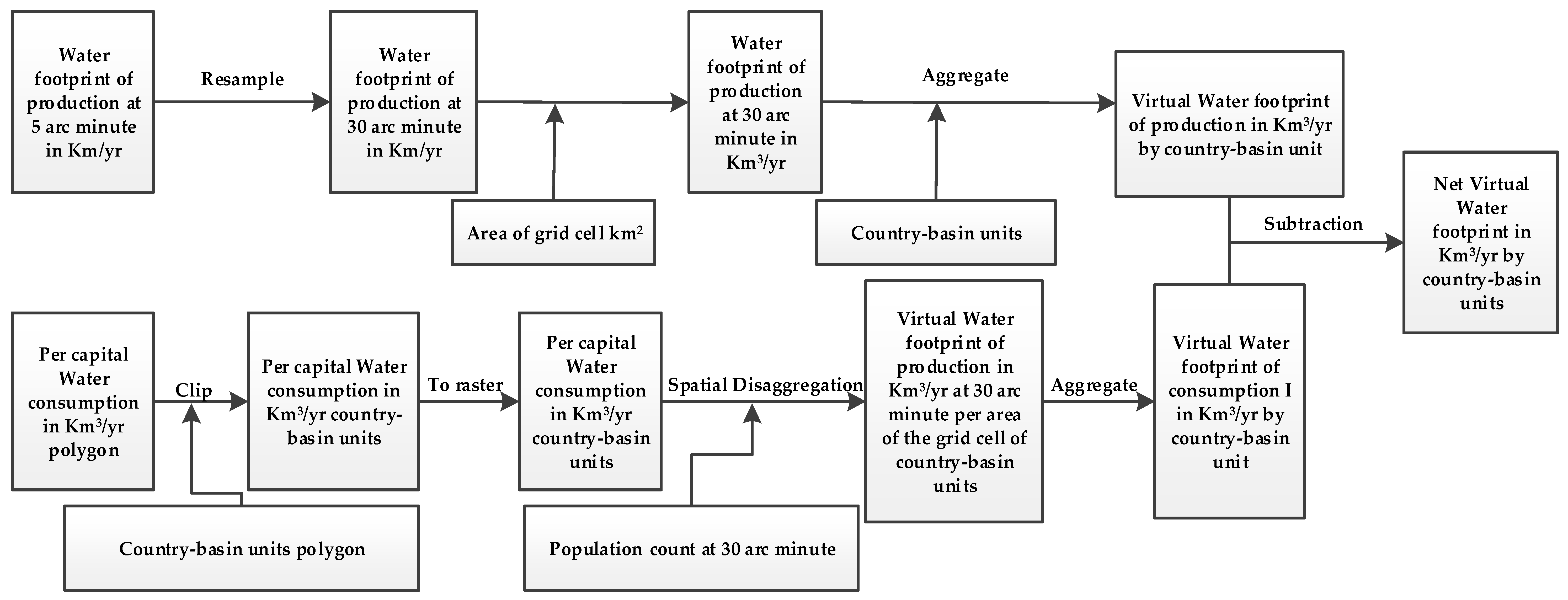
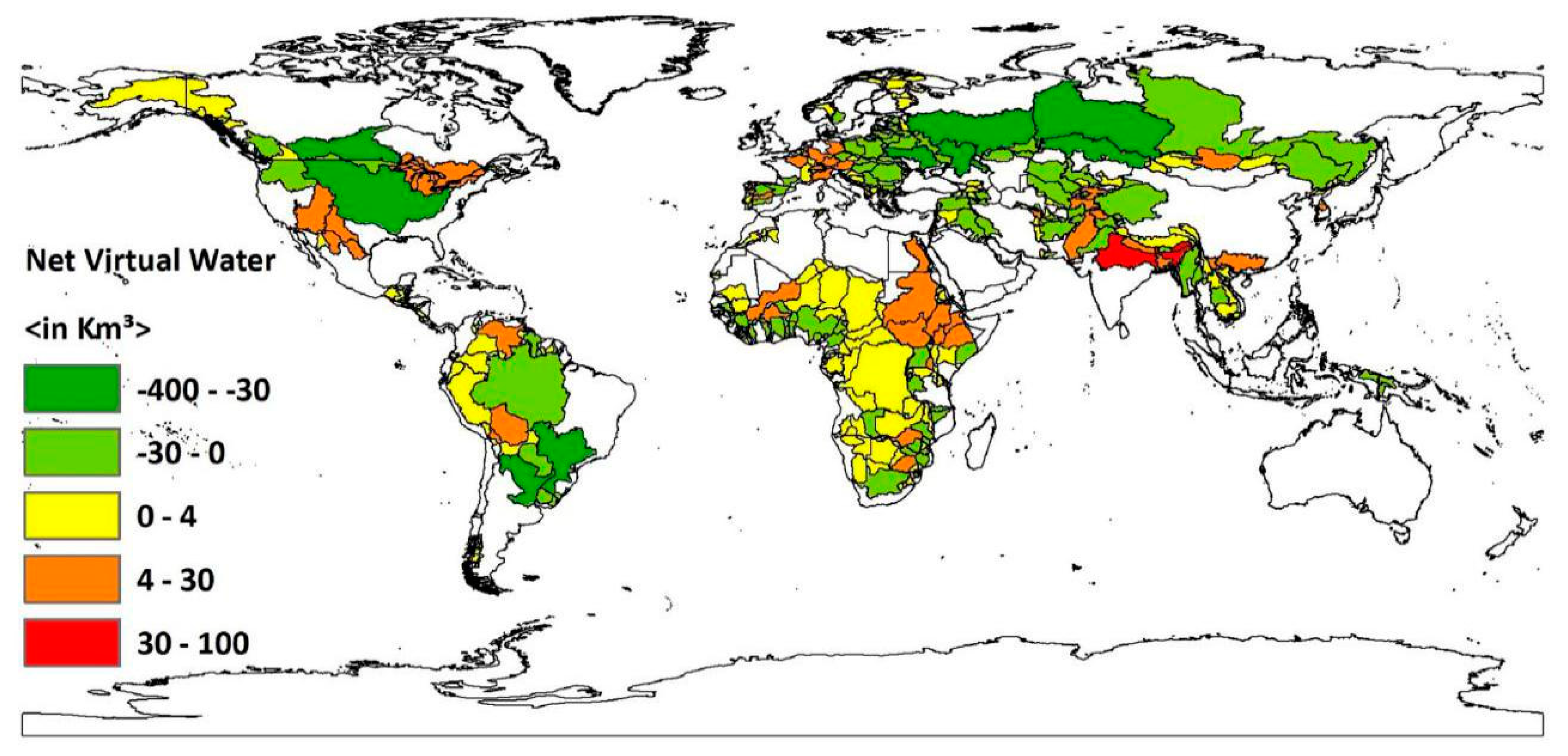
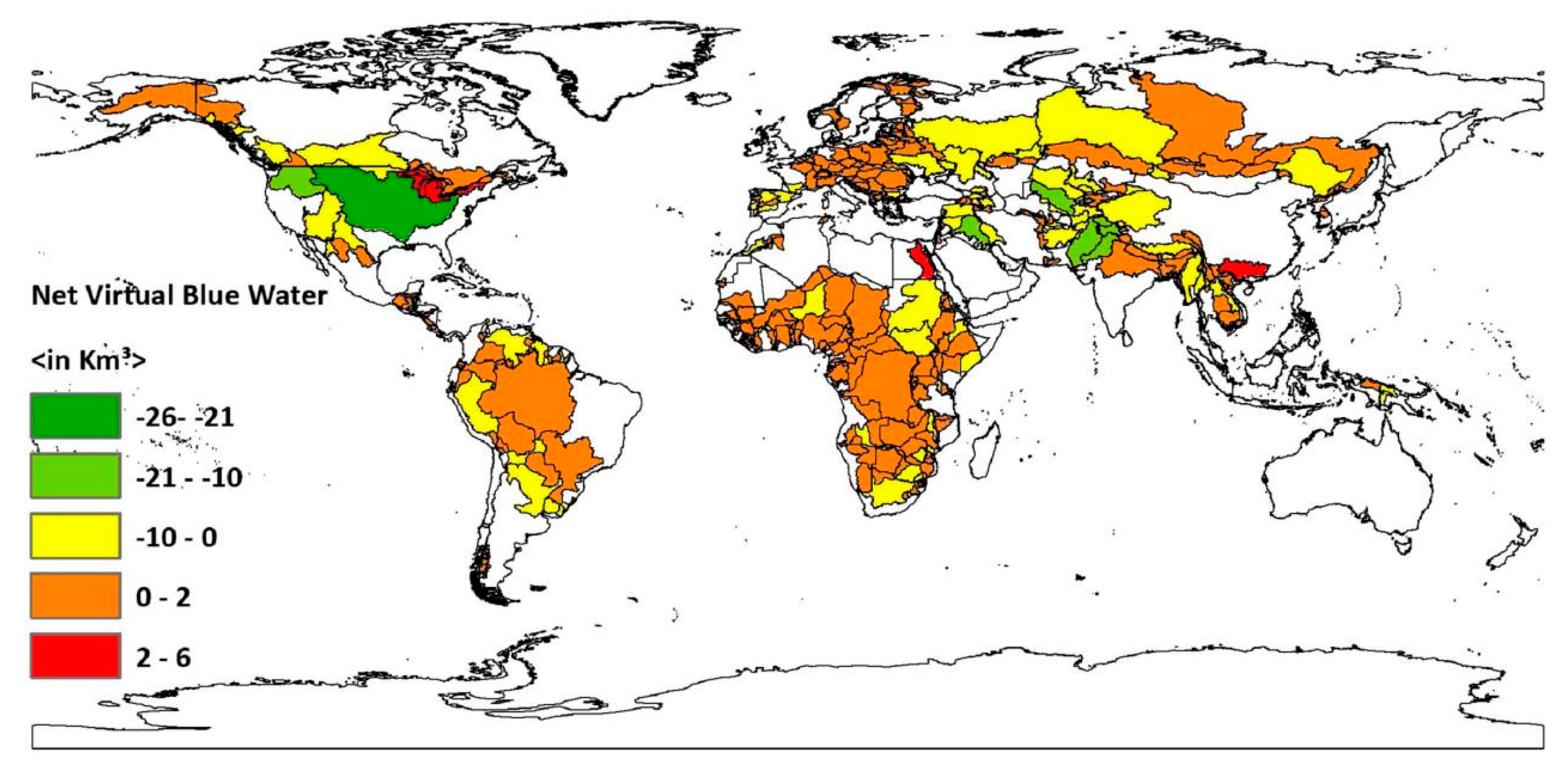
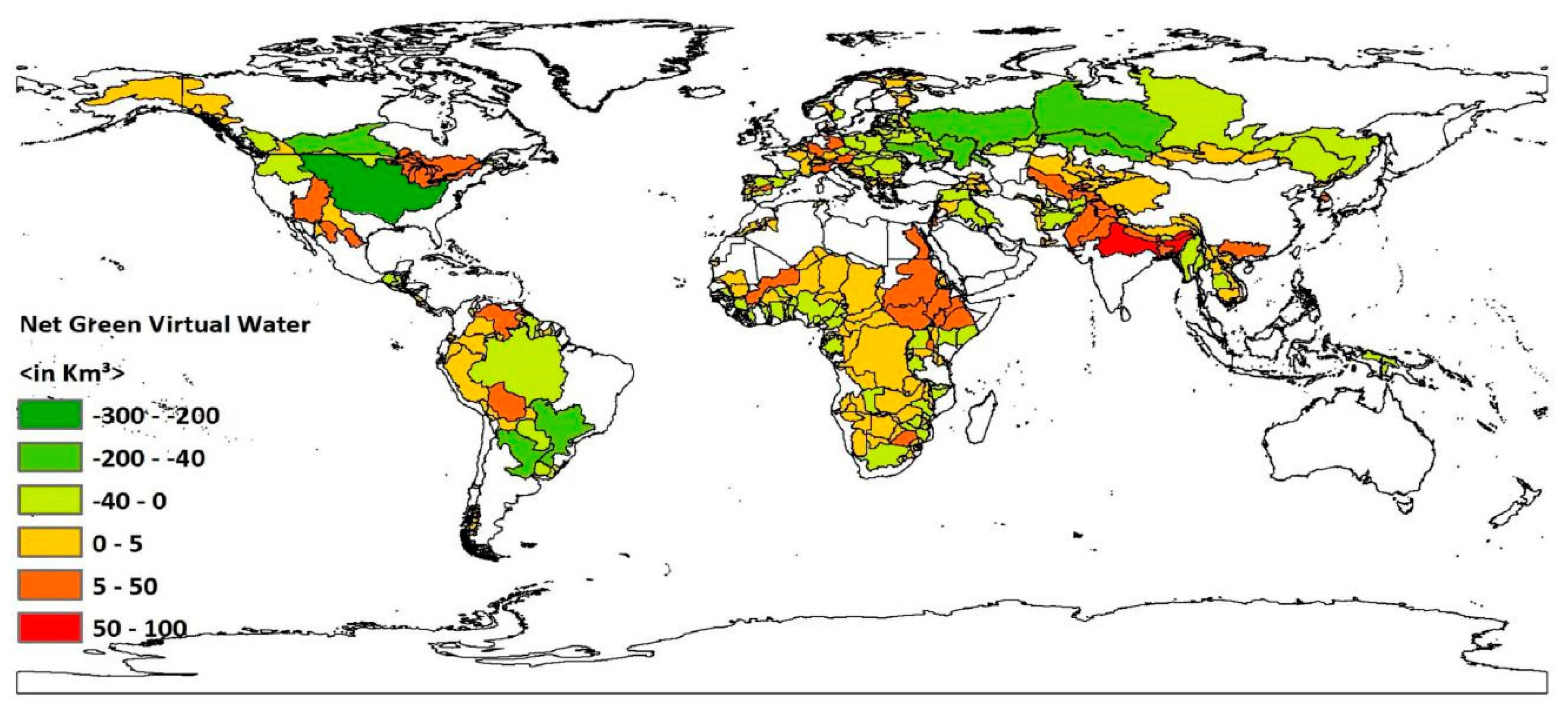
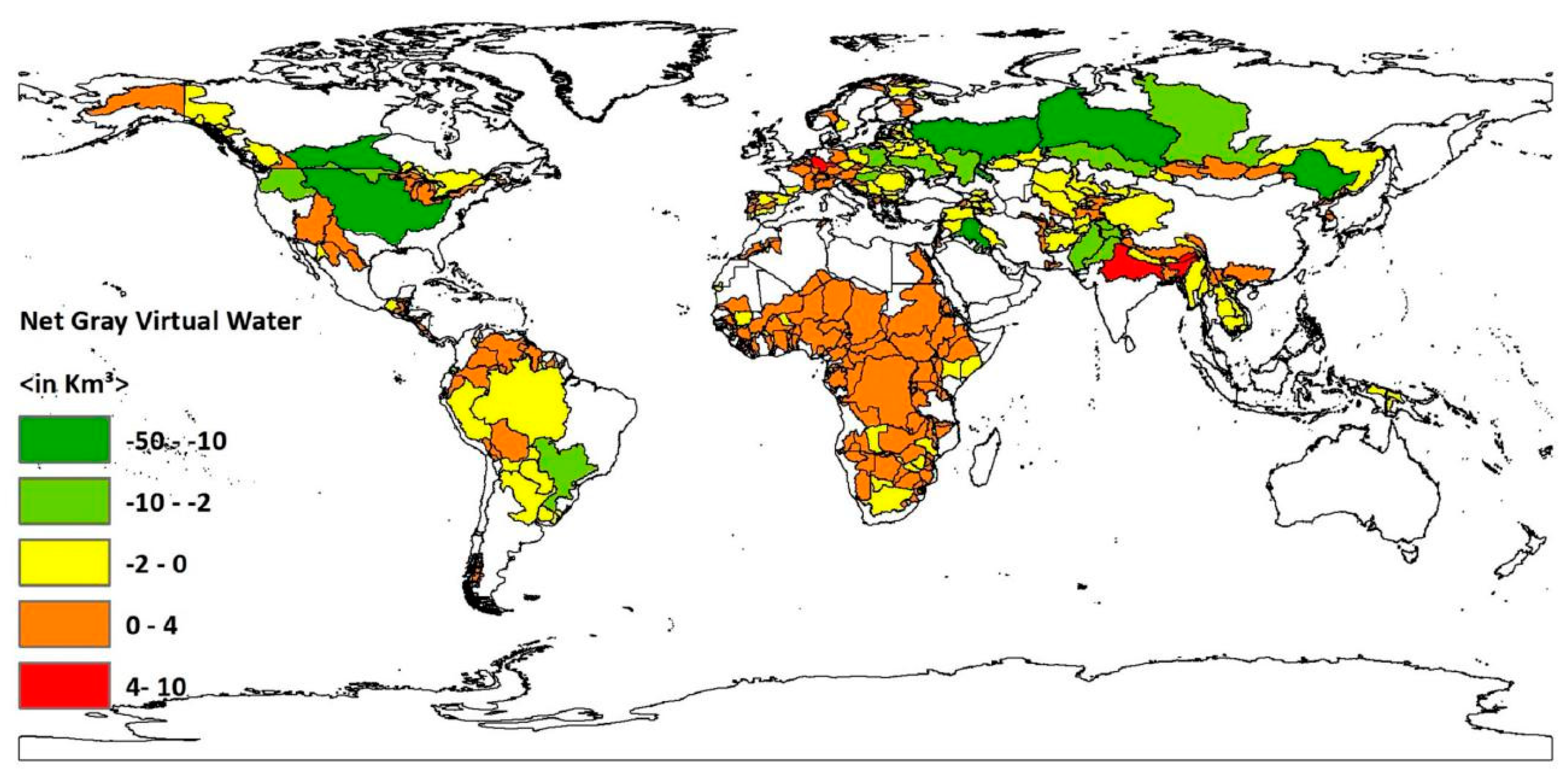
| Virtual Water Balance per Country−Basin Unit | ||||||
|---|---|---|---|---|---|---|
| Blue Virtual Water Balance per Country−Basin Unit | ||||||
| Range in km3 | −26 to 21 | −21 to −10 | −10 to 0 | 0 to 2 | 2 to 6 | |
| Number of Country−Basin Units | 2 | 4 | 97 | 459 | 3 | |
| Green Virtual Water Balance per Country−Basin Unit | ||||||
| Range in Km3 | −300 to 200 | −200 to −40 | −40 to 0 | 0 to 5 | 5 to 50 | >50 |
| Number of Country−Basin Units | 1 | 7 | 187 | 339 | 30 | 1 |
| Gray Virtual Water Balance per Country−Basin Unit | ||||||
| Range in Km3 | −50 to −10 | −10 to −2 | −2 to 0 | 0 to 4 | 4 to10 | |
| Number of Country−Basin Units | 4 | 13 | 156 | 390 | 2 | |
| Total Virtual Water Balance per Country−Basin Unit | ||||||
| Range in Km3 | −400 to −30 | −30 to −0 | 0 to −4 | 4 to −30 | 30 to −100 | |
| Number of Country−Basin Units | 10 | 193 | 322 | 37 | 3 | |
| The number of country-basin units which imports and exports net virtual water and country−basin unit as well as area coverage and population count | ||||||
| Virtual water | Export | Import | ||||
| Number of Country−Basin Units | Population Number in Million | Area in million km2 | Number of Country−Basin Units | Population Number in Million | Area in million km2 | |
| Blue | 104 | 510.59 | 2718.25 | 461 | 1998.57 | 3681 |
| Green | 196 | 627.12 | 3358.5 | 369 | 1882.03 | 3041.25 |
| Gray | 174 | 649.08 | 3735 | 391 | 1860.08 | 3735 |
| Total | 204 | 739.67 | 3595.25 | 361 | 1767 | 2804.5 |
© 2019 by the authors. Licensee MDPI, Basel, Switzerland. This article is an open access article distributed under the terms and conditions of the Creative Commons Attribution (CC BY) license (http://creativecommons.org/licenses/by/4.0/).
Share and Cite
Wu, X.; Degefu, D.M.; Yuan, L.; Liao, Z.; He, W.; An, M.; Zhang, Z. Assessment of Water Footprints of Consumption and Production in Transboundary River Basins at Country-Basin Mesh-Based Spatial Resolution. Int. J. Environ. Res. Public Health 2019, 16, 703. https://doi.org/10.3390/ijerph16050703
Wu X, Degefu DM, Yuan L, Liao Z, He W, An M, Zhang Z. Assessment of Water Footprints of Consumption and Production in Transboundary River Basins at Country-Basin Mesh-Based Spatial Resolution. International Journal of Environmental Research and Public Health. 2019; 16(5):703. https://doi.org/10.3390/ijerph16050703
Chicago/Turabian StyleWu, Xia, Dagmawi Mulugeta Degefu, Liang Yuan, Zaiyi Liao, Weijun He, Min An, and Zhaofang Zhang. 2019. "Assessment of Water Footprints of Consumption and Production in Transboundary River Basins at Country-Basin Mesh-Based Spatial Resolution" International Journal of Environmental Research and Public Health 16, no. 5: 703. https://doi.org/10.3390/ijerph16050703
APA StyleWu, X., Degefu, D. M., Yuan, L., Liao, Z., He, W., An, M., & Zhang, Z. (2019). Assessment of Water Footprints of Consumption and Production in Transboundary River Basins at Country-Basin Mesh-Based Spatial Resolution. International Journal of Environmental Research and Public Health, 16(5), 703. https://doi.org/10.3390/ijerph16050703







